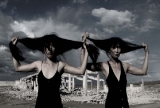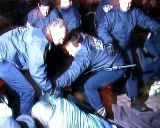Fractured geographies #2
A New World Border
Friday, January 8, 2010 – 8:30 pm
Border Art Workshop / Guillermo Gomez Peña & Isaac Artenstein
Laura Waddington / No Border Camp / Almagul Menlibayeva
Maison Pop’ de Montreuil
Free admission
In this second session, entitled “A New World Border” in homage to the book by Chicano artist Guillermo Gómez-Peña, we’ll see how artists, video artists and performers, working from their experiences of migration and exodus, unravel our imaginary and geopolitical borders to better reformulate new topographies.
Exodus – Almagul Menlibayeva (2009, 11 min)
 With Exodus, Almagul Menlibayeva draws on the nomadic traditions and shamanic rites of contemporary Kazakhstan to narrate her own experience of cultural exodus and global uprooting. Born in 1969 in Kazakhstan, Almagul Menlibayeva graduated from the University of Art and Theatre in her native Almaty in 1992. She now lives in Amsterdam and Berlin. Often anchored in the mythologically rich Kazakh steppes, Menlibayeva’s videos offer a romantic and melancholy reflection on the complex heritage buried in these landscapes and in the ruins of the Soviet era. Exodus was presented at the 2009 Venice Biennale.
With Exodus, Almagul Menlibayeva draws on the nomadic traditions and shamanic rites of contemporary Kazakhstan to narrate her own experience of cultural exodus and global uprooting. Born in 1969 in Kazakhstan, Almagul Menlibayeva graduated from the University of Art and Theatre in her native Almaty in 1992. She now lives in Amsterdam and Berlin. Often anchored in the mythologically rich Kazakh steppes, Menlibayeva’s videos offer a romantic and melancholy reflection on the complex heritage buried in these landscapes and in the ruins of the Soviet era. Exodus was presented at the 2009 Venice Biennale.
Border Art Workshop / Taller de Arte Fronterizo
(1986-2000, 18 min) – unseen in France
 Following in the footsteps of the Chicano Art Movement, which emerged in the United States in the 1970s, the legendary Border Art Workshop (BAW) / Taller de Arte Fronterizo (TAF) collective has been working on the political, cultural and imaginary topos of the border since 1985, through site-specific actions on the Mexican-American border. While the Chicano Art movement had already asserted the notion of border culture, and posited Spanglish (a hybrid language of Spanish and English invented by Mexican migrants to the USA), as a poetics of cultural hybridization, the emergence of BAW / TAF, founded in San Diego, by Isaac Artenstein, Sara Jo Berman, Jude Eberhard, Guillermo Gomez-Pena and Michael Schnorr, coincided with the enactment of new migration laws in the United States, an industrial intensification of the border, and the new centrality of multiculturalism in American artistic debates. Between political activism and land art, BAW/TAF denaturalizes the border, becoming both wall and passage, suture and break. San Diego-Tijuana 1986-2000 (selection from the BAW/TAF video archive, 20 min) :
Following in the footsteps of the Chicano Art Movement, which emerged in the United States in the 1970s, the legendary Border Art Workshop (BAW) / Taller de Arte Fronterizo (TAF) collective has been working on the political, cultural and imaginary topos of the border since 1985, through site-specific actions on the Mexican-American border. While the Chicano Art movement had already asserted the notion of border culture, and posited Spanglish (a hybrid language of Spanish and English invented by Mexican migrants to the USA), as a poetics of cultural hybridization, the emergence of BAW / TAF, founded in San Diego, by Isaac Artenstein, Sara Jo Berman, Jude Eberhard, Guillermo Gomez-Pena and Michael Schnorr, coincided with the enactment of new migration laws in the United States, an industrial intensification of the border, and the new centrality of multiculturalism in American artistic debates. Between political activism and land art, BAW/TAF denaturalizes the border, becoming both wall and passage, suture and break. San Diego-Tijuana 1986-2000 (selection from the BAW/TAF video archive, 20 min) :
End of the line (October 12 1986, 3 min.), Counter Performance Light Up the Border (1987, 3 min.), El Bordo-Tijuana (198, 3 min.), Oh George Oh Panama (October 19 1989, 4 min.), Brownsville to Tijuana – Border Sutures (1990, 2 min.), 600 Crosses 20 miles per hour (2000, 3 min)
Son of border crisis – Guillermo Gómez Peña
(1990, 17 min) – unseen in France
 Guillermo Gómez-Peña, a “post-Mexican Chicano” who emigrated to California, is an internationally renowned performer, writer and video artist. He is a founding member of BAW/TAF and, in 1993, of the transdisciplinary collective La Pocha Nostra. His video performances, co-directed with Isaac Artenstein, work towards the emergence of a world of borders: a “new world border” as an alternative to the “new world order”, through the invention of a formidable poetic language and grotesque, raging stagings that call into question the racist America of the 1980s. The BAW/TAF and Guillermo Gómez-Peña videos are shown for the first time in France.
Guillermo Gómez-Peña, a “post-Mexican Chicano” who emigrated to California, is an internationally renowned performer, writer and video artist. He is a founding member of BAW/TAF and, in 1993, of the transdisciplinary collective La Pocha Nostra. His video performances, co-directed with Isaac Artenstein, work towards the emergence of a world of borders: a “new world border” as an alternative to the “new world order”, through the invention of a formidable poetic language and grotesque, raging stagings that call into question the racist America of the 1980s. The BAW/TAF and Guillermo Gómez-Peña videos are shown for the first time in France.
No Borders Camp / Campamento Contra Fronteras, Mexicali/Calexico – MONO MONO
(2007, 9min) – unseen in France
 The No Borders Camp / Campamento sin Fronteras, Mexicali/Calexico took place in 2007 on the Mexican-American border. The camp – which grew out of the libertarian and activist movements for cross-border solidarity with migrants – follows in the tradition of No Borders camps organized around the world since the 1990s. In addition to demands for freedom of movement and the abolition of borders and migration controls, the No Border Camp is at the heart of new activisms using the militant Internet, decentralized networks, and the alternative production and circulation of information.
The No Borders Camp / Campamento sin Fronteras, Mexicali/Calexico took place in 2007 on the Mexican-American border. The camp – which grew out of the libertarian and activist movements for cross-border solidarity with migrants – follows in the tradition of No Borders camps organized around the world since the 1990s. In addition to demands for freedom of movement and the abolition of borders and migration controls, the No Border Camp is at the heart of new activisms using the militant Internet, decentralized networks, and the alternative production and circulation of information.
Border – Laura Waddington (2004, 27 min)
English filmmaker Laura Waddington, born in 1970, offers a rare opportunity with her film Border, and by the yardstick of her own ordeal, the fragile, elegiac power of cinema to capture the condition of migrants in the Sangatte camp, and at the same time an analysis of repressive migratory control mechanisms. Laura Waddington’s videos have been shown at numerous international film festivals and in exhibitions and museums such as the Centre Pompidou and the Reina Sofia Museum in Madrid.


A New World Border : Prophecies, poems & loqueras for the end of the century de Guillermo Gómez-Peña was published by City Light Books San Francisco in 1996.